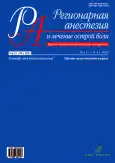Opiode-saving anesthesia and analgesia as a component of ERAS in endoscopic adrenalectomy in obese patients
- Authors: Neimark M.I.1, Kiselev R.V.1, Goncharov E.V.2
-
Affiliations:
- Altai State Medical University
- Clinical Hospital RZD-Medicine
- Issue: Vol 15, No 4 (2021)
- Pages: 277-286
- Section: Original articles
- URL: https://journals.rcsi.science/1993-6508/article/view/108390
- DOI: https://doi.org/10.17816/1993-6508-2021-15-4-277-286
- ID: 108390
Cite item
Abstract
BACKGROUND: Anesthetic management during interventions on the adrenal glands is quite complex. Difficulties in conducting anesthesia are often determined by concomitant obesity, which is associated with an increased sensitivity of the respiratory center to the action of opioids. This condition contributes to an increase in the frequency of respiratory and other disorders with the use of opioids.
AIM: This work aimed to study the influence of different variants of perioperative anesthesia and analgesia administered during retroperitoneoscopic adrenalectomy in obese patients during the perioperative period.
MATERIALS AND METHODS: A randomized study of 94 patients who underwent retroperitoneoscopic adrenalectomy for adrenal neoplasms was performed. Depending on the type of perioperative analgesia, the patients were divided into two groups. In group 1 (n=33), the operation was performed under combined anesthesia based on the low-flow desflurane inhalation; for perioperative analgesia, only systemic opioid administration was provided. In group 2 (n=30), the operation was performed under anesthesia based on low-flow desflurane inhalation in combination with the blockade of the fascial space of the erector muscle. In group 3 (n=31), the operation was performed under anesthesia based on desflurane in combination with drugs for non-opioid analgesia. critical incidents.
RESULTS: Surgical intervention of the wound under inhalation anesthesia with ESP blockade (ropivacaine) and a combination of drugs for non-opioid analgesia promotes faster post-anesthetic rehabilitation, effective postoperative analgesia, and fewer complications in the early postoperative period compared with anesthesia using systemic opioid analgesics. This effect contributed to significantly shorter hospitalization of 97 hours for group 2 (95% CI 85-102) (p=0,042) and 94 hours for group 3 (95% CI 82-101) (p=0,039) compared with the 126 hours for group 1 (95% CI 114-135).
CONCLUSIONS: Anesthesia based on desflurane in combination with ESP blockade and a multiple drugs for non-opioid anesthesia is an effective method that promotes fast post-anesthesia rehabilitation and shortens the hospitalization period for retroperitoneoscopic adrenalectomy for aldostectomy in the perioperative period.
Full Text
##article.viewOnOriginalSite##About the authors
Mihail I. Neimark
Altai State Medical University
Email: rector@agmu.ru
ORCID iD: 0000-0001-9135-6392
MD, Dr. Sci. (Med.), Prof.
Russian Federation, 40, Lenin Ave, Barnaul, 656038Roman V. Kiselev
Altai State Medical University
Author for correspondence.
Email: rector@agmu.ru
ORCID iD: 0000-0003-3290-6221
MD, Cand. Sci. (Med.)
Russian Federation, 40, Lenin Ave, Barnaul, 656038Evgeniy V. Goncharov
Clinical Hospital RZD-Medicine
Email: jecci777@mail.ru
ORCID iD: 0000-0002-0680-681X
MD
Russian Federation, BarnaulReferences
- Shen WT, Sturgeon C, Duh QY. From incidentaloma to adrenocortical carcinoma: the surgical management of adrenal tumors. J Surg Oncol. 2005;89(3):186–192. doi: 10.1002/jso.20180
- Walz MK, Alesina PF, Wenger FA, et al. Posterior retroperitoneoscopic adrenalectomy--results of 560 procedures in 520 patients. Surgery. 2006;140(6):943–948; discussion 948-950. doi: 10.1016/j.surg.2006.07.039
- Epshtein SA. Perioperative anesthetic management in morbidly obese patients. Regional anesthesia and acute pain management. 2012;6(3):5–27. (In Russ).
- Lihvancev VV, Mironenko AV, Gabitov MV, et al. Successful implementation of shortened postoperative period program after ten hours of general anaesthesia in patient with morbid obesity. Russian journal of Anaesthesiology and Reanimatology. 2014;(3):77–79. (In Russ).
- Dekkers OM, Horvath-Puho E, Jorgensen JO, et al. Multisystem morbidity and mortality in Cushing’s syndrome: a cohort study. J Clin Endocrinol Metab. 2013;98(6):2277–2284. doi: 10.1210/jc.2012-3582
- Stuijver DJ, van Zaane B, Feelders RA, et al. Incidence of venous thromboembolism in patients with Cushing’s syndrome: a multicenter cohort study. J Clin Endocrinol Metab. 2011;96(11):3525–3532. doi: 10.1210/jc.2011-1661
- Thorell A, MacCormick AD, Awad S, et al. Guidelines for Perioperative Care in Bariatric Surgery: Enhanced Recovery After Surgery (ERAS) Society Recommendations. World J Surg. 2016;40(9):2065–2083. doi: 10.1007/s00268-016-3492-3
- Alvarez A, Singh PM, Sinha AC. Postoperative analgesia in morbid obesity. Obes Surg. 2014;24(4):652–659. doi: 10.1007/s11695-014-1185-2
- Chin KJ, Adhikary S, Sarwani N, Forero M. The analgesic efficacy of pre-operative bilateral erector spinae plane (ESP) blocks in patients having ventral hernia repair. Anaesthesia. 2017;72(4):452–460. doi: 10.1111/anae.13814
- Epshtein SL, Azarova TM, Storozhev VY, et al. General anesthesia without opioids in surgery for morbid obesity. What for and how? Regional Anesthesia and Acute Pain Management. 2016;10(1):47–54. (In Russ). doi: 10.18821/1993-6508-2016-10-1-47-54
- Mulier JP, Wouters R, Dillemans B, De Kock M. A randomized controlled, double-blind trial evaluating the effect of opioid-free versus opioid general anaesthesia on postoperative pain and discomfort measured by the QoR-40. J Clin Anesth Pain Med. 2018;2(1):015.
- Aldrete J, Kroulik D. Post-anesthesia recovery score. Anesth. & Analg. 1970;49:924–29.
- Duncan PG, Shandro J, Bachand R, Ainsworth L. A pilot study of recovery room bypass («fast-track protocol») in a community hospital. Can J Anaesth. 2001;48(7):630–636. doi: 10.1007/BF03016195
- Vadivelu N, Mitra S, Narayan D. Recent advances in postoperative pain management. Yale J Biol Med. 2010;83(1):11–25. PMC2844689
Supplementary files







